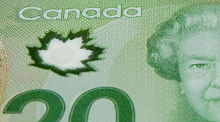
The Canadian dollar continued its slide south on Thursday, dipping below the 80-cent US mark to its lowest level in nearly six years.
Canada’s major banks are forecasting the loonie to continue on its downward path — a trajectory that will likely alter what sectors of the economy see the decline as a positive or a negative.
“There’s always winners and losers when the currency sits at any given level,” said Avery Shenfeld, chief economist for CIBC World Markets.
Shenfeld said the lower dollar should provide a boost to the Canadian export sector and improve job prospects.
On the flip side, Shenfeld noted the weaker loonie will make it more expensive for Canadians to buy imported goods and to travel abroad.
The Canadian dollar fell again Thursday to 79.3 cents US, its lowest value since April 2009.
CIBC released a report Thursday that predicts the Canadian dollar to bottom out at 77 cents US in the middle of 2015 before it starts climbing back up in the second half of the year.
“But we do have to remember that by historic standards, the Canadian dollar actually isn’t that weak,” Shenfeld said.
“We’ve just come off a period of a few years where it was quite overvalued compared to where it historically had been.”
The country’s weakening oil and gas sector are partly responsible for the falling dollar, as is the Bank of Canada’s recent cut to its trend-setting interest rate.
With these conditions — among others — the loonie is expected to continue its decline, Scotiabank strategist Camilla Sutton wrote in a note to clients Thursday.
The dollar fell about 7.4 per cent since the start of the year and 15 per cent since its July 2014 high, Sutton wrote.
“The environment has turned rapidly against CAD (the Canadian dollar) and we are likely to see ongoing weakness in 2015,” she wrote.
Sutton added if oil markets fail to stabilize, the loonie will fall even further, particularly since the Bank of Canada has tied its decisions on the country’s trend-setting interest rate directly to crude.
Last week, the central bank blamed the oil slump for its unexpected move to cut its interest rate for the first time since 2009. It nudged a quarter point lower to 0.75 per cent.
“The Bank of Canada denies that it’s directly targeting the exchange rate but knows that, by cutting interest rates, a byproduct of that will be a weaker Canadian dollar,” Shenfeld said.
Several banks, including CIBC, TD Bank and the National Bank of Canada, are now predicting the central bank to cut its interest rate by another quarter percentage point in March.
“The Bank of Canada rarely moves interest rates only once,” Shenfeld said.
“It’s like potato chips, once you eat one, you’re at least on the course for a second.”